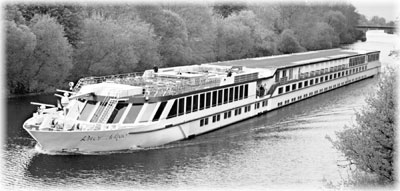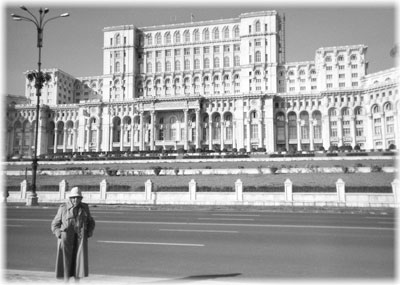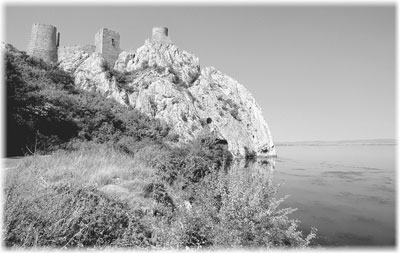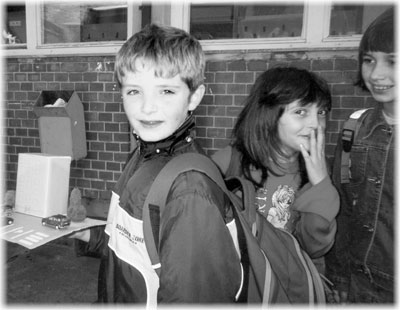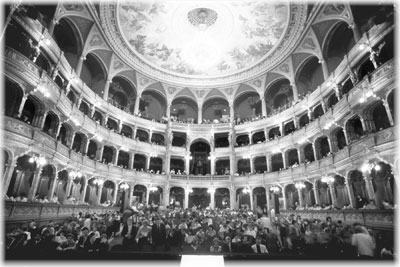Bucharest to Budapest — An Eastern European river cruise
by June L. Griffin, Lewiston, ME
The prospect of a trip to Eastern Europe was made very attractive by the thought of stepping ashore in five countries — Romania, Bulgaria, Serbia & Montenegro, Croatia and Hungary — from the comfort of a luxurious river vessel. Just a decade ago Russia dominated these countries, which are now enjoying a taste of freedom, and in October ’05 I spent two weeks visiting this diverse region of Europe.
The ship
My trip was what Grand Circle Travel, based in Boston, calls a Small Ship Voyage. We traveled on a long, narrow river ship designed to navigate the rivers of Europe and enter less-traveled ports.
Grand Circle’s fleet of custom-built ships were all launched between 1998 and 2003. The ship I was on, M/S River Adagio, was built in 2003 and has a passenger capacity of just 164 people. All of the cabins have outside windows, and the four decks are served by an elevator. The cabins have details like those found in a deluxe hotel and are designed for double occupancy with two beds that convert into sofas in the daytime.
The ship has floor-to-ceiling windows in the lounge and restaurant and a wonderful sundeck, where we enjoyed the sunny fall weather as we viewed the scenic riverbank.
Romania
To begin this trip, I flew from Boston’s Logan Airport to Frankfurt, Germany, on Lufthansa, having a long layover in Frankfurt as there are not many flights to Bucharest, Romania, where I was to start the tour. I overnighted in the city center at the Sofitel Bucharest.
I had visited Romania twice before, the first time when the country was still open and the second when the country was under dictator Nicolae Ceauşescu’s imposed and devastating regime, which destroyed the Romanian economy and kept the people completely under his rule.
On my 2005 visit, I found a different country. Since the death of Ceauşescu, Romania has become a republic. A visible reminder of the past, however, is the Parliament Palace, a mammoth official building he had built, often cited as the second largest in the world after the Pentagon. The dictator had blocks of historic buildings torn down to erect this huge tribute to himself, which he named The House of the People, pouring all of the country’s money into touches like gold ceilings. Today it houses the Romanian Parliament, and it was a highlight of our city tour of Bucharest.
We boarded our ship in Constant¸a, a Romanian city east of Bucharest on the Black Sea, after taking a train ride of about an hour on a private train. The next day, in sunny October weather, we had a city tour of Constant¸a, named after Emperor Constantine.
Roman ruins could be seen everywhere, including a huge Roman mosaic that was discovered in 1959 and is now part of a museum of Roman artifacts.
Entrance to the Danube
We then began sailing along the Danube-Black Sea Canal to the Iron Gate, an entrance into the Danube River. Until the 1970s, when the system of locks was installed, the river could be traveled only at certain times of the year when the water level was high enough. Now the Danube forms a much-traveled link to the Black Sea.
Passengers on the River Adagio had to stay up late if they wanted to watch the ship’s passage through the Iron Gate, as we passed through between 11 p.m. and 3 a.m. Later we passed through the Agegia Lock in the daytime, and it was fascinating to see our ship just fitting through the narrow walls of the lock. Commentary from the captain of our ship about the Danube-Black Sea Canal and its locks was helpful.
Bulgaria
The next country we reached was the Republic of Bulgaria, situated on the Black Sea and with the Danube River flowing through it. Bulgaria, a former Communist country, is hoping to join the European Union in 2007. I had visited the capital city, Sofia, several years earlier. Some of the city is dominated by grand, socialist-style buildings left over from the days of Russian rule, but the central square, where I watched a changing of the guard, is more interesting.
Our ship docked at the city of Rousse, a major Bulgarian port on the Danube, and we were able to take a shuttle bus for the short ride into town. On a lovely sunny day, we sat in the town’s central square, Freedom Square, with its circular fountain. The modern and luxurious Danube Plaza Hotel is also located on the square and was a good place to exchange money. (New, crisp U.S. dollar bills were accepted in the shops along the side streets, and credit cards were preferred, but changing travelers’ checks was a problem.)
On to Serbia
After a day of cruising, our next stop was Belgrade, the capital of Serbia & Montenegro.
The River Adagio docked at the town of Veliko Gradiste and a bus took us to Belgrade, where we had a tour of the city, including a visit to the Kalemegdan Citadel, a huge fortress on a hilltop which overlooks the meeting of the Sava and Danube rivers. We also spent time at a very modern mall in the heart of the city and enjoyed a treat of roasted chestnuts bought from a man with a charcoal grill.
Back on board the ship, we learned more about this new part of Eastern Europe through a lecture, “Serbia-Montenegro: Past and Present,” which was very helpful in understanding the great changes going on there.
Our next stop was at Novi Sad, northwest of Belgrade, an economic and cultural center with a population of over 300,000. We spent time in the historic town square where, in 1992, 10,000 people demonstrated against then President Milosevic.
Novi Sad is rebuilding after sustaining damage from the NATO bombardment of the recent war. At one time, Novi Sad was left without bridges, means of communication or water. We saw a pontoon bridge which was serving as a temporary replacement for a bridge that was destroyed in 1999.
The people we encountered in Serbia & Montenegro seemed glad to welcome some American tourists, and while in Novi Sad we were treated to a program of music and dances by local entertainers who came aboard the ship to perform for us before dinner.
Croatia
We had to have our passports checked for our entrance into Croatia the next day, the only time on the cruise that this was necessary. We passed through Customs in the town of Vukovar, the site of the worst shelling in the Croatian-Serbian war. We saw houses being repaired and many still with damaged roofs and bullet holes.
We went by bus to visit Osijek, a large city on the River Drava. Once a Roman town, it was also occupied by the Turks who, in 1528, burned down the city to rebuild in their own style. Despite 2,000 years of upheaval, the city of Osijek offers interesting sights.
Passengers, in groups of eight people, were invited to join Croatian families for lunch. We visited a small home and were served soup, stuffed peppers in sauce, bread and a fine pastry dessert. The young man at our lunch spoke English well, giving us a glimpse into life in Croatia during its recent war and talking about the efforts to rebuild.
We also were treated to a visit to a local school in Osijek, one that is supported by the Grand Circle Foundation, and we were welcomed by delightful children who performed songs and plays, some in English. The students and teachers made us feel very welcome, and we gave the children small items that we had with us.
The people of Croatia call their country “our beautiful homeland” and want visitors to come and enjoy their now-stable country.
Hungary
Our ship sailed 868 miles along the Danube until it docked at Budapest, Hungary, where we disembarked to spend three nights in this famous city. Our hotel was the Novotel Budapest Centrum, located in a busy section of the city.
I have visited Budapest several times and have admired its famous attractions, like the Royal Palace, the Fisherman’s Bastion with views over the city, the famous Chain Bridge and the enormous Parliament building on the Pest side. I toured this huge building in 2003 and was impressed with its grandeur and the jeweled Hungarian Crown on display.
The huge open space of Heroes Square was another stop on our tour.
We had a morning visit to Szentendre, a charming small town outside Budapest where artists have worked for 200 years. The narrow cobblestone streets are filled with galleries and shops selling arts and crafts. Here I bought a necklace of real Baltic amber, which was of good design and fairly priced.
On our last day in Budapest, we took a taxi into the center of the city to visit a favorite place, the famous Gerbeaud House pastry shop located at Váci utca, a boulevard of shops and an excellent place to sit and enjoy the scene.
Budapest also offers visitors musical programs at the State Opera House and restaurants to suit every taste.
This was a great trip, and I enjoyed seeing Europe’s heartland from the vantage point of a deluxe ship while traveling on one of Europe’s great rivers.
For information, contact Grand Circle Travel (phone 800/321-2835 or visit www.gct.com).


